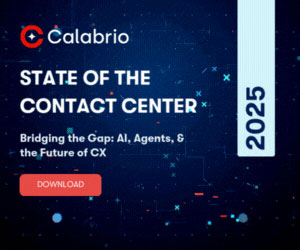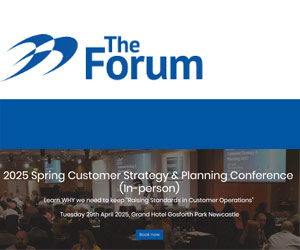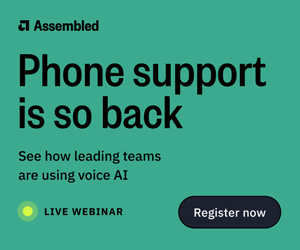Calabrio explores the key differences between omnichannel and multichannel contact centres, the benefits of omnichannel strategies, and the essential software features and best practices needed to succeed in 2025.
Calling, email, texting, instant messaging, social media – the communication channels available to us today can seem almost endless.
This proliferation has fundamentally reshaped how we interact, not just in our personal lives, but also in the world of business and service.
What’s perhaps most important, though, is that it’s also reshaped expectations for interactions. As consumers, we expect more than the flexibility of multiple channels. We expect speed, convenience, and above all, consistency. As businesses, we need to deliver.
That’s why, to offer customer experience excellence across all these touchpoints, the key word is not “multichannel” but “omnichannel.”
But what’s the difference exactly? And why is it so critical to customer service and the all-important hub that is the omnichannel contact centre?
Get up to date on these details and much more in this guide to the omnichannel contact centre. Find out what it takes to deliver winning service and sales experiences across channels – including the best omnichannel contact centre software options to support your efforts in 2025.
What Is an Omnichannel Contact Centre?
Omnichannel contact centre defined:
An omnichannel contact centre is a unified communications hub that integrates all communication channels into a single platform, enabling agents to deliver a friction-free customer experience across every touchpoint, whether for service or sales.
Importantly, omnichannel contact centres do more than just offer multiple channels; they connect them. This way, whether a customer starts on chat, continues via email, and finishes on social media, the agent sees the entire interaction history.
The Cloud-Based Software Behind the Scenes
Beyond a simple definition of the term, it’s impossible to talk about the omnichannel contact centre without talking about omnichannel contact centre software solutions that make them possible.
In fact, when people use the term “omnichannel contact centre” they may actually be referring to the software that’s enabling their omnichannel capabilities.
Omnichannel contact centre software is the engine that powers this unified view. Based in the cloud, these contact centre solutions are what provide the connection between all channels, giving agents the tools to both communicate and manage conversations efficiently.
In addition to enabling communications, omnichannel contact centre software typically tracks interactions, automates workflows, and provides data insights to improve performance. Ultimately, without this software, a true omnichannel strategy is impossible.
Why Omnichannel Matters Today
In our connected world, omnichannel isn’t optional – it’s expected. Customers demand businesses meet them on their preferred channels and remember past interactions.
Failing to do so risks losing customers. An omnichannel contact centre enables businesses to meet these expectations, boost satisfaction, and build loyalty.
Omnichannel vs. Multichannel: The Key Difference in Contact Centre Strategy
It’s vital to distinguish between multichannel and omnichannel. Multichannel simply offers support across multiple channels, but they operate independently.
An agent on the phone might be unaware of a previous email exchange. This leads to fragmented experiences and frustrated customers.
Omnichannel breaks down these silos. It connects all channels, creating a unified customer journey. Agents see the complete interaction history, regardless of the channel.
This allows for faster, more personalized, and more effective support. Multichannel offers multiple paths; omnichannel offers a seamless journey.
And that’s why an omnichannel contact centre is the key to true customer-centricity and exceptional experiences.
What Are the Benefits of Having an Omnichannel Contact Centre?
An omnichannel contact centre offers a wealth of benefits, impacting everything from customer satisfaction to operational efficiency.
Building and improving an omnichannel contact centre is both a necessary response to today’s customer demands and a strategic investment that pays dividends in numerous ways.
Happy Customers, Loyal Customers
The potential to improve customer satisfaction is perhaps the most obvious – and the most significant – benefit. Customers appreciate the convenience of choosing their preferred channel and the consistency of personalized service.
No more repeating information or struggling to get their issues resolved. This leads to increased loyalty and positive word-of-mouth.
Streamlined Operations, Efficient Agents
Omnichannel contact centre software streamlines operations by consolidating all communication into a single platform.
Agents have a 360-degree view of the customer journey, reducing handling time and improving first-call resolution. Automated workflows further enhance efficiency, freeing up agents to focus on more complex issues.
Data-Driven Insights, Continuous Improvement
The integrated nature of an omnichannel contact centre provides valuable data insights. Businesses can track key metrics related to agent performance, customer satisfaction, and operational efficiency across all channels.
This gives decision-makers the ability to identify overarching trends as well as pinpoint more minute opportunities for improvement. This data-driven intelligence supports ongoing optimization of the customer experience while helping to support and engage employees.
Cost Savings + Increased Revenue = Greater ROI
While the initial investment in software and implementation might seem daunting, an omnichannel approach to customer service can bring an incredible return on investment.
By operating more efficiently and increasing overall productivity, organizations can reduce costs. Plus, driving improved customer satisfaction drives repeat business and increased revenue.
A Future-Proof Contact Centre Strategy
In today’s competitive landscape, providing omnichannel service and sales is necessary to securing your business’s future, ensuring it can adapt to evolving customer preferences and emerging communication channels.
In the meantime, if you follow the right best practices, you can open up a competitive advantage, turning your contact centre into not only a hub for quality service but also an engine of growth.
5 Essential Omnichannel Contact Centre Best Practices
Implementing and managing an omnichannel contact centre is anything but a set-it-and-forget it affair. Unlocking those benefits we’ve covered above requires careful planning, strategic execution, and a commitment to continuous improvement.
These best practices below are must-haves for any contact centre looking to make the most of their omnichannel strategy.
Map the Complete Customer Journey
Understanding your customer’s journey – including when and where they communicate with you, online and off – is integral to understanding what your omnichannel contact centre must deliver. Identify all the touchpoints they interact with, from initial research to post-purchase support.
Rely on Accurate, Automated Forecasting
Customers may use a range of channels, but not all channels are created equally. Nor is any day or season the same for one contact centre.
Having an accurate picture of current and future demand is key to offering consistent and quality service in an efficient manner.
We’ll talk software more later but for now, know that having great forecasting and scheduling tools at your disposal is essential.
Empower Your Agents
Your agents are the front line of your omnichannel strategy. They need to be empowered and engaged to deliver results.
Develop a clear workforce engagement management (WEM) strategy, and leverage the right tools to support them with the data, coaching, and flexibility they need to handle interactions effectively and manage their work–life balance.
Your contact centre software should provide a unified agent desktop and access to complete customer history. But meanwhile, specialized solutions like self-scheduling tools, gamification, and automated quality management may be required to deliver real impact.
Embrace Automation Wisely
Automation can significantly improve efficiency, but it should be used strategically. Look for software that automates routine tasks, such as after-call work (ACW), and provides elevated self-service options.
Ultimately, omnichannel contact centres should strike the right balance between automation and human interaction. Chatbot analytics tools can improve bots’ ability to handle more queries, freeing up agents to focus on more complex issues.
AI call summarization can summarize and evaluate interactions, streamlining ACW and accelerating performance insights.
With the explosion in AI-driven technologies, there’s no shortage of ways to leverage contact centre automation in 2025.
Iterate. Improve.
The omnichannel contact centre is designed to solve a huge historical challenge: how can businesses get a clear view of the entire customer experience when it’s divided up across so many touchpoints? Today’s software ensures that experiences are not just visible but measurable.
To make the most of these insights, set clear KPIs for different aspects of performance and review them regularly. Find out what’s working and what’s not. And above all, don’t forget to leverage the voice of your customer. After all, it’s the customer that knows best.
Why Software Is So Crucial to the Omnichannel Contact Centre
While the concept of omnichannel is about strategy and customer experience, the reality of omnichannel relies heavily on the right software.
As we’ve explored throughout this guide so far, without robust software, an effective omnichannel operation simply isn’t possible. It’s the foundation upon which seamless customer journeys and efficient agent workflows are built.
The Glue That Holds It All Together
Omnichannel contact centre software acts as the central hub, connecting all communication channels and providing the tools necessary to manage them effectively.
But it’s more than a switchboard; it’s a sophisticated platform that integrates data, automates processes, and empowers agents to deliver exceptional service.
Must-Have Features and Capabilities of Omnichannel Contact Centre Software
To fuel better customer experiences and outcomes, though, not just any software will do. If you’re looking for your first omnichannel solution – or you’re looking for an upgrade – start by looking for tools that offer these capabilities (or easily integrate with solutions that do)
Unified Agent Desktop
A single interface for agents to access all communication channels, customer history, and relevant information.
Omnichannel Routing
Intelligent routing that directs interactions to the most appropriate agent based on skills, availability, and customer context, regardless of the channel.
Real-Time Channel Switching
The ability for agents and customers to seamlessly transition between channels during a single interaction (e.g., moving from chat to voice).
Complete Interaction History
A 360-degree view of every customer interaction across all channels, providing valuable context for personalized service.
Automation
AI- and machine learning-driven functions, as well as even simpler rules-based process automation, are now table stakes for contact centre solutions.
Look for software that accelerates or eliminates time-consuming tasks to support contact centre teams and customers alike.
Reporting and Analytics
It’s all about visibility. You need comprehensive reporting and analytics to track performance and deliver predictive insights.
Plus, tools like sentiment analysis, desktop analytics, and speech analytics can help you drill down on key aspects of interactions.
Just be sure that you take these tools for a spin first – technology must be as easy to use as it is innovative if you want it to make a difference.
Workforce Optimization (WFO)
From forecasting and scheduling to agent performance management, workforce-focused processes are just as important to contact centre optimization as enabling omnichannel communications.
Make sure your CCaaS is up to the task – or is capable of easily integrating a comprehensive WFO solution that is.
API and Integrations: WFO solutions aren’t the only thing your contact centre software should connect with. Open APIs and integrations with other business systems (CRM, marketing automation, HR and back office systems, etc.) are necessary to create a seamless flow of information.
This blog post has been re-published by kind permission of Calabrio – View the Original Article
For more information about Calabrio - visit the Calabrio Website
Call Centre Helper is not responsible for the content of these guest blog posts. The opinions expressed in this article are those of the author, and do not necessarily reflect those of Call Centre Helper.
Author: Calabrio
Reviewed by: Jo Robinson
Published On: 7th Apr 2025 - Last modified: 8th Apr 2025
Read more about - Guest Blogs, Calabrio






 The digital foundation of a customer-centric contact centre, the Calabrio ONE workforce performance suite helps enrich and understand human interactions, empowering contact centres as a brand guardian. Calabrio ONE unites workforce optimisation (WFO), agent engagement, and business intelligence solutions into a cloud-native, fully integrated suite.
The digital foundation of a customer-centric contact centre, the Calabrio ONE workforce performance suite helps enrich and understand human interactions, empowering contact centres as a brand guardian. Calabrio ONE unites workforce optimisation (WFO), agent engagement, and business intelligence solutions into a cloud-native, fully integrated suite. 




























